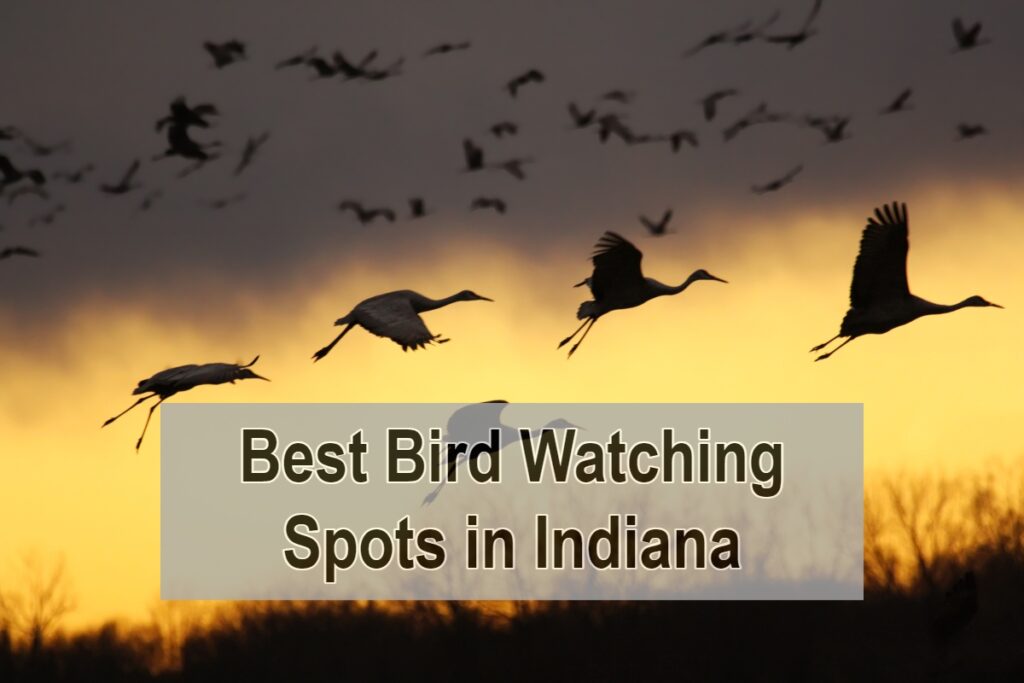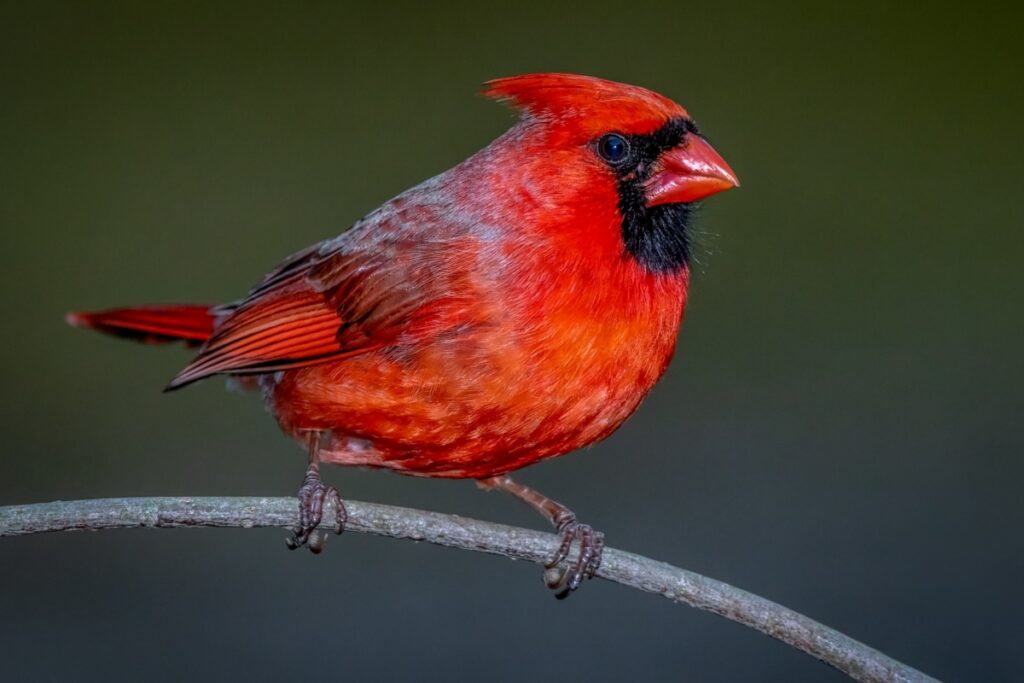As an Amazon Associate, we earn from qualifying purchases with no additional costs for you.
Indiana is located between Illinois in the west and Ohio in the east. At least 390 bird species have been recorded in Indiana, making this an excellent destination for birders. It is not so easy knowing the best bird spots, though, so I compiled this list of the best places to bird watch in Indiana.
The best bird watching spots in Indiana are those near Lake Michigan but isolated in urban areas, such as Hammond Lake Front Park and Bird Sanctuary. Other places with wetlands and various habitats, such as Celery Bog and Muscatatuck National Wildlife Refuge, are reasonable.
A table giving the most exciting birds you can see at each of my top 12 birding spots in Indiana:
| PARK | INTERESTING BIRDS YOU CAN SEE |
|---|---|
| Eagle Creek Park | Red-shouldered Hawk and Yellow-throated Warbler |
| Indiana Dunes State Park | Kirtland’s Warbler and Long-tailed Duck |
| Muscatatuck National Wildlife Refuge | Bald Eagle and American Bittern |
| Hammond Lake Front Park and Bird Sanctuary | Connecticut Warbler and Black-and-white Warbler |
| Willow Slough Fish and Wildlife Area | Sandhill Crane and Marsh Wren |
| Falls of the Ohio State Park | Lesser Black-backed Gull and Peregrine Falcon |
| Goose Pond/Beehunter Marsh Fish and Wildlife Area | Dickcissel and Bonaparte’s Gull |
| Pokagon State Park | Great Horned Owl and Common Gallinule |
| Potato Creek State Park | Northern Shrike and Red-shouldered Hawk |
| Celery Bog | Indigo Bunting and Osprey |
| Mary Gray Bird Sanctuary | Black-billed Cuckoo and Eastern Whip-poor-will |
| Summit Lake State Park | Common Yellowthroat and Yellow Warbler |
Read on to learn more about which species can be found in my top bird watching spots in Indiana.
TIP: If you want to check out the best pair of binoculars for bird watching, we recommend a pair of waterproof and fog-proof 8 x 42 binoculars like the Celestron – Outland X 8×42 Binoculars (Amazon link).
Best Places to Bird Watch in Indiana
Indiana is not a large state, only being ranked 38th in size, but it still has a lot to offer because the northern part abuts Lake Michigan, and there is a range of other habitats in the state.
1. Eagle Creek Park
This park is in Indianapolis and is rich in species, with over 270 birds recorded. The park also has informative exhibits you can look at and observation decks where you can bird watch.
The area also has a reservoir that attracts waterfowl and shorebirds. Habitats found here include wetlands, grassy fields, and woodlands.
Some of the bird species you can find at Eagle Creek Park are as follows: Blue-winged Warbler, Prothonotary Warbler, Red-shouldered Hawk, Willow Flycatcher, Acadian Flycatcher, and Yellow-throated Warbler.
2. Indiana Dunes State Park
Indiana Dunes State Park is on the shoreline of Lake Michigan. Many waterfowl and other birds are found in the area, including migrating songbirds. There is a land trail and a marsh trail you can walk on, allowing you to see different birds.
Kirtland’s Warbler is a reason to visit this park because this is an endangered species not seen in many places. Other warblers to look out for here include Prairie Warblers and Pine Warblers.
In winter, you can see some waterfowl on the lake. Birds like Long-tailed Ducks and Red-throated Loons are often seen here.
3. Muscatatuck National Wildlife Refuge
This refuge is found in southeastern Indiana. It has a diversity of habitats for birds, including cropland, scrub, hardwood forest, and upland forest. It also has wetlands that attract waterfowl; you can find birds that like marshy areas and shorebirds.
Some birds you can find here include Wood Ducks, Ruddy Ducks, Mute Swans, and Trumpeter Swans. There are also Bald Eagles that breed in the refuge.
You can drive on the 4-mile car route and visit the platform at Endicott Marsh. Check for American Bitterns, Marsh Wrens, Virginia Rail, King Rail, Black Rail, and Sora at the marsh.
Sandhill Cranes can occur in the refuge in winter. A checklist of the 265 bird species has been recorded here.
TIP: Knowing how to spot the birds in your yard is key to enjoying visits from your winged friends as much as possible! The best sources are trusted books, I recommend using the following (Amazon links):
– National Geographic Field Guide to the Birds of North America
– National Audubon Society Birds of North America
4. Hammond Lake Front Park and Bird Sanctuary
This park is an excellent spot to find migrating birds because it is found between an urban area and Lake Michigan. Birds tend to be funneled into this park while on migration. The park is a 600-meter wooded area located on the shores of Lake Michigan.
Three hundred fifty-three bird species have been recorded here, including many warblers during migration. You can find species such as American Redstart, Magnolia Warbler, Connecticut Warbler, Black-and-white Warbler, and Common Yellowthroat.
You may even see Rose-breasted Grosbeaks and Blackpoll Warblers moving among the branches of trees. May to the middle of September is the optimal time for finding migrating warblers. You can access a bird species checklist for the area, which is helpful when you visit.
5. Willow Slough Fish and Wildlife Area
Willow Slough Fish and Wildlife Area is a 9,956-acre region with an impoundment known as J.C. Murphey Lake. The lake is 1,200 acres and is a good bet for finding waterfowl.
You can also find good birds in the marshy areas of the refuge. Birds you can see in the refuge include the following species: Sedge Wren, Marsh Wren, Swamp Sparrow, and Henslow’s Sparrow.
The two wren species and the Swamp Sparrows occur in the moister grassland and marsh areas, as do Henslow’s Sparrows. Ovenbirds and Kentucky Warblers are often seen in thicker vegetation near the ground or on the land.
Grasshopper Sparrows and Dickcissels can be located in grassland areas. Dickcissel males often sing from the tops of grasses. Sandhill Cranes and Bell’s Vireos have also been recorded here at various times.
TOP TIP: During the cold winter months, finding food could be difficult for wild birds. Should you feed them? Read this article to discover the correct way to feed birds during winter. If birds get injured, will they help each other? Find out here.
6. Falls of the Ohio State Park
The falls of the Ohio State Park are famous among birders in Indiana. You can find birds like Great Blue Herons, Double-crested Cormorants, and Black-crowned Night Herons here.
There are a couple of gulls to watch out for, specifically Ring-billed Gulls, Lesser Black-backed Gulls, Bonaparte’s Gulls, and Iceland Gulls.
In terms of raptors, you can find Peregrine Falcons, Bald Eagles, and Osprey here. The Osprey and Bald Eagles will be close to or over areas of water.
7. Goose Pond/Beehunter Marsh Fish and Wildlife Area
This region consists of 9,098 acres of habitat in wetlands and prairie grasslands. There is an excellent visitor center with exhibits.
At Goose Pond/Beehunter Marsh Fish and Wildlife Area, you can see bird species like Black-necked Stilts, American Black Ducks, Greater White-fronted Geese, and Wilson’s Phalaropes.
The grassland in the area has been restored and provides habitat for species such as the Dickcissel, Northern Bobwhite, and Grasshopper Sparrow. You can likely see Sandhills and Whooping Cranes in the region at times.
TIP: Check out my recommended products if you are looking for the best and trusted equipment for birdwatching in the wild or on your backyard (Amazon link):
- Celestron Outland X 8×42 Binoculars
- Celestron Ultima 80 Angled Spotting Scope
- National Audubon Society Birds of North America Book
- Design Free-standing Bird Bath
- Smart Bird Feeder with Camera
- Cedar Bird House for Outside
8. Pokagon State Park
Pokagon State Park in northeastern Indiana is 1,260 acres in size and is on the edge of Lake James. Waterfowl that nest in the area include Hooded Mergansers.
Other nesting species include marsh-loving species like Virginia Rail and Sora. You can also find owls here, specifically Barred Owls and Great Horned Owls.
Common Gallinules, along with the Sora and Virginia Rails, can all be seen on the lake’s edges near or in the reeds or other marsh vegetation.
Songbirds to look out for include Cerulean Warblers, American Redstarts, and Hooded Warblers. Yellow-headed Vireos and Acadian Flycatchers have also been recorded in the trees.
9. Potato Creek State Park
Potato Creek State Park is located south and west of Southbend. Several waterfowl are found here in winter, including species like the Common Loon and Hooded Merganser. Northern Shrikes can also sometimes be found in winter in the park.
You can find woodland birds like the Veery and Wood Thrush, often located on the ground or low in the undergrowth. Other birds to look out for include the Red-shouldered Hawks that actually breed in the park.
Look for Green Herons in wooded areas near the water and Great Blue Herons in the more open areas.
10. Celery Bog
This small area has a record of over 250 bird species, making this a must-visit site for bird watchers. Four trails are available in the area to walk along while looking out for birds. The habitats here include more than the swampy area; there is also marshland and woodlands.
Bird species include: Pied-billed Grebe, Great Blue Heron, Wood Duck, and Double-crested Cormorant. There are also Green Herons and Great Egrets to watch out for.
Both Bald Eagles and Osprey move through the refuge during migration, and you can expect to find many songbirds in spring and fall migration. Birds such as the beautiful Baltimore Oriole and stunning Indigo Bunting make a visit here worth it for birders.
11. Mary Gray Bird Sanctuary
This area is 700 acres, and the Indiana Audubon Society manages it. It is a popular site in Fayette County for bird banding activities and research. The sanctuary has prairies, forests, and wetlands, attracting various birds.
Many bird species are here, especially during the annual fall and spring migration. At least 180 species of birds have been recorded in the sanctuary. You can see waterfowl here, such as Hooded Mergansers, Wood Ducks, Ring-necked Ducks, and Blue-winged Teals.
Shorebirds to watch out for when water levels are low include Spotted Sandpipers, Least Sandpipers, Pectoral Sandpipers, Solitary Sandpipers, and Greater Yellowlegs.
You can find Eastern Whip-poor-wills here and the less common cuckoo, the Black-billed Cuckoo. Several warblers and other songbirds frequent the area during migration.
Species such as the Philadelphia Vireo and Red-eyed Vireo can be spotted in the trees. At the same time, Gray-cheeked Thrushes and Swainson’s Thrushes can be found on the ground and lower down in the forest understory.
12. Summit Lake State Park
This is a 2,680-acre park in Central Indiana. It has a record of 270 bird species found in diverse habitats. You can find a lake, scrub, prairie, and patches of forest, providing lots of spots for birds.
You can find several birds here, including the following: Willow Flycatchers, Indigo Buntings, and Common Yellowthroats. Yellow Warblers can also often be seen in summer, actively foraging in the trees.
Waterfowl you can find include Hooded Mergansers, Green-winged Teal, and Northern Pintails. Scoter species and Long-tailed Ducks are also found in the lake at various times.
Many birders like the park because of the many waterfowl attracted by the lake. It is also worth looking for the Bald Eagles near the water and along the edges, since they nest in the park.
Best Time to Bird Watch in Indiana
Indiana is always a good state to go bird watching in. There are more significant numbers of certain birds during migration, so you may want to plan a trip depending on what species you aim to add to your life list.
| TYPES OF BIRDS | SEASON |
|---|---|
| Warblers and grosbeaks | May to September |
| Sandhill Cranes | Spring |
The Indiana State Bird
The state bird of Indiana is the Northern Cardinal. These birds are sexually dimorphic, meaning the males look different from the females. Male birds are bright red, while females are brown with a red tinge on the face. Juveniles resemble females.
The cardinal is found in gardens but also in woodlands. The birds are easy to see when present and are quite vocal, calling often. The call is quite distinctive once you learn to recognize it.
Bird Watching Laws in Indiana
You are prohibited from having or interfering with migratory birds, including their eggs, nests, or young. Similarly, you are prohibited from selling or transporting any such migratory wild birds.
My Favourite Equipment for Bird Watching
Bird watching is one of the least expensive hobbies out there, but you still need some equipment to get the most out of it.
The essential equipment to start bird watching is a pair of binoculars. My preference is 8 X 42 binoculars. The number 8 is how much the magnification is, while 42 is the field of view in millimeters of the lenses.
A pair of waterproof and fog-proof 8 x 42 binoculars like the Celestron – Outland X 8×42 Binoculars on Amazon is an excellent choice for both beginners and experts.
In time, you can choose more expensive models and also opt to buy a spotting scope like the Celestron Ultima 80 on Amazon.
These are a lot more expensive compared with binoculars though, so if you are only a beginner, start with binoculars first. A spotting scope is only helpful for birds far away, such as out on a pond or seashore.
There are a few rules or guidelines you should abide by as an ethical birder. These are listed below.
- Do not enter private lands without prior permission from landowners.
- Follow all the rules in refuges and reserves, including cleaning up any garbage from your campsite.
- Do not disturb birds on nests.
- Do not use apps and play songs to call up birds when they are hungry, tired, and breeding during spring and summer.
Conclusion
Indiana is a state with much to offer when it comes to bird watching. You can find more habitats than expected because the state is not significant.
There are also areas along the shores of Lake Michigan that prove fruitful for migrating songbirds. All-in-all, you cannot go wrong by adding Indiana to your list of must-visit birding sites.
TIP: If you want to check out the best pair of binoculars for bird watching, we recommend a pair of waterproof and fog-proof 8 x 42 binoculars like the Celestron – Outland X 8×42 Binoculars (Amazon link).


